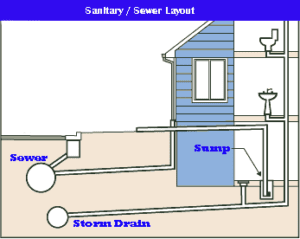Plumbing Inspection – Residential
Plumbing Inspection includes inspecting the components and materials of a home during a home inspection. The water used in your homes plumbing system typically will come from a municipal source or a private source such as a well, lake or river etc. The actual water supply source is not included in the scope of a residential home inspection. Water supply from wells are are typically from a shallow well, which is no deeper than 30 feet, or a deep well, where the pump is located in the well itself.
Plumbing Inspection – Water Supply Lines
Water Supply Lines – When buying a home in an older area of a town it is important to contact your local water and sewer department to find out if your municipal supply line has been updated. There are some municipalities which still have lead supply lines installed. If the home is in older part of town and road is old it is a good possibility that no recent work has taken place on municipal services. Lead filters are relatively inexpensive and can protect your family from any harmful effects of having lead piping.
Plumbing Inspection – Potable Water Testing
Most Real Estate Agents will pick up a Free Water Sample Bottle and have your water tested prior to closing date. ( Free bacterial testing of water supplies is available from Public Health Ontario ) If you are buying a rural property and are having your water tested you have to ensure the water sample is taken before any filters or UV light filters to ensure you are sampling the actual water supply. Testing water after it passes through a UV light filter is basically a waste of time as the UV light kills any bacteria.
Plumbing Inspection – Sump Pumps
Every home in Ontario is required to have a sump pump or alternate method of providing drainage of any water collected from the drainage tile ( weeping tile ) installed around the perimeter house. Many larger cities have a storm sewer system installed which is used to provide drainage for your homes drainage tile system.
Many home owners who do not have a Storm Sewer to dispose of collected water will make an illegal connection into the Sanitary Sewer in their basement. Connecting your sump pump discharge into the sanitary sewer is illegal and the home owner could be fined. Any water collected in the Sanitary Sewer has to be treated by the Municipality which is expensive.
Back up sump pumps are common where the home is in an area of high water table or they had experienced a pump failure which resulted in a flood. There are battery back up systems designed to protect the home in event of power failure. Another type of back up sump pump works on your Municipal water supply which would not be effected by power failure.
Any type of sump pump system should be checked on a regular schedule to ensure it is in proper working order and ready to protect your home.
Kitec Plumbing
Plumbing Inspection – Kitec plumbing was installed in many homes between 1997 and 2007 and has since been found to suffer from leaks and premature failure. A 125 Million dollar lawsuit payout just ended in January of 2020. The only solution is to have the Kitec completely removed and replaced with new supply lines. Some Kitec plumbing has been installed in concrete for in-floor heating systems. Kitec was also installed in many condominiums and could also be embedded in concrete. Read Kitec Plumbing article.
Galvanized Plumbing
Galvanized pipe is steel or iron pipe that has a protective layer of zinc added to help prevent corrosion. Galvanized plumbing was widely used in homes built before 1960. The life expectancy of galvanized pipes is between 20 and 80 years and is near or past its life expectancy for many homes. Over time galvanized pipes tend to rust and corrode on the inside which can lead to low water pressure and possibly even burst pipes. Many insurance companies will not insure a home that has any galvanized plumbing installed. Read article on Century Homes
Pex Plumbing
Pex plumbing has mostly replaced the use of copper in residential homes in subdivisions. Most of Pex pipe failures have been linked to piping and fitting. Piping fails when the pipes are exposed to chlorine that is within the water, exposure to direct sunlight before its installation. Furthermore PEX pipe is vulnerable when it comes in contact with such solutions as petroleum products and oxygen. It can leach toxic chemicals from pipe material also. On the other hand, fitting failure is caused by dezincification that results to corrosion and finally creating leaks. Dezincification of brass fittings it the major cause of fitting failure. There are varied opinions available on any type of Pex Plumbing that is available. Some insurance companies will not insure homes that have certain types of Pei Plumbing installed, so it is recommended that you contact your insurance company prior to purchasing a home to ensure that your particular brand of Pex will not disqualify you from obtaining insurance.
Some examples of problems found in Pex Piping installations:
- PEX-A (Uponor/Wirsbo and Rehau): dezincification of fittings and chemical leaching/odor (AquaPEX only)
- PEX-B (Zurn & Viega): dezincification of fittings
- PEX-C (Nibco/CPI/DuraPEX): cracked, leaking pipes
- PEX-AL-PEX (Kitec/IPEX): dezincification of fittings
Read Understanding Your Home Inspection article.
Barrie Home Inspection will inspect your plumbing and advise of any defects or potential upgrading that maybe required. Kitec plumbing was used primarily for in-floor heating. Lawsuit information here.
Inspection Areas
Alliston
Angus
Barrie
Innisfil
Orillia
Midland
Penetanguishene
Newmarket
Wasaga Beach
Certifications





